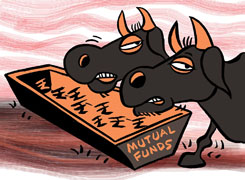In this volatile market, which Mutual Fund segment should I invest in for the next 5 years?
Ramalingam Kalirajan |10894 Answers |Ask -Follow
Mutual Funds, Financial Planning Expert - Answered on Oct 30, 2024
He has an MBA in finance from the University of Madras and is a certified financial planner.
He is the director and chief financial planner at Holistic Investment, a Chennai-based firm that offers financial planning and wealth management advice.... more

Dear Sir, 1. In today's crumbling markets which segment of MF I should adopt for next 5 years. 2. Exactly which funds I should have in my portfolio Thank you for your
1. Focus on Growth with Balanced Risk
Given current market conditions, aim for funds that balance growth potential and moderate risk. Here’s a structured approach:
Balanced Focus: Consider a mix of funds with equity, debt, and hybrid exposure. Balanced funds provide stability, even during market fluctuations, and allow for steady growth.
Growth-Oriented Segments: Large-cap, multi-cap, and flexi-cap funds can be wise choices in today’s market. Large-caps offer stability with blue-chip companies, while multi-cap and flexi-cap funds give you access to mid-cap and small-cap segments, which are primed for long-term growth.
Debt Allocation: Include some debt funds, especially short-term bond funds, to counterbalance market volatility. Debt funds stabilize your portfolio, providing regular returns during equity downturns.
2. Types of Funds to Include
Here’s a broad breakdown of fund categories that suit a five-year horizon:
Large-Cap Equity Funds: These funds invest primarily in top companies. They are less volatile and typically recover faster after market downturns.
Flexi-Cap Funds: They give fund managers the flexibility to invest across market caps based on market conditions, allowing for growth while managing risk.
Hybrid Funds: Balanced hybrid funds or aggressive hybrid funds (with a 60-70% equity allocation) combine equity and debt to provide growth with a cushion against major losses.
Short-Term Bond Funds: They can help meet near-term goals and improve liquidity while providing steady returns.
3. Suggested Fund Selection Strategy
A Certified Financial Planner can guide you to suitable funds based on your unique risk profile and goals. Here’s a framework to consider:
Actively Managed Equity Funds: Actively managed funds often outperform passive funds in specific sectors. They offer an edge with active risk management and higher returns in a fluctuating market.
Avoid Direct Funds: Consider investing in regular funds with an MFD. Direct funds lack the professional guidance and structured support regular funds offer.
Review Performance and Expense Ratios: Assess each fund’s performance history over five years and expense ratio. Lower expense ratios directly benefit returns, while a strong past performance indicates reliable fund management.
4. Suggested Mutual Fund Portfolio Allocation
To provide a sample allocation strategy:
Equity Allocation:
40% in large-cap and multi-cap funds for stability and growth
20% in flexi-cap funds for exposure across market caps
Debt Allocation:
25% in short-term bond funds for stability
15% in liquid funds or money market funds for easy access
Taxation of Capital Gains on Mutual Funds
Keep in mind the taxation on your mutual fund investments:
Equity Mutual Funds: Long-term capital gains (LTCG) above Rs 1.25 lakh attract a 12.5% tax. Short-term capital gains (STCG) incur a 20% tax rate.
Debt Mutual Funds: Both long-term and short-term gains are taxed according to your income tax slab. This makes debt funds more suitable for stability rather than long-term capital appreciation.
Final Insights
Your five-year plan will benefit from a thoughtful allocation across diversified fund categories. Combining equity growth funds, balanced hybrid funds, and debt funds provides a 360-degree approach, balancing growth with stability.
With consistent monitoring and a balanced mix, your portfolio can weather market fluctuations, helping you achieve sustainable growth in the long term.
Best Regards,
K. Ramalingam, MBA, CFP
Chief Financial Planner
www.holisticinvestment.in
https://www.youtube.com/@HolisticInvestment
You may like to see similar questions and answers below
Ulhas Joshi |280 Answers |Ask -Follow
Mutual Fund Expert - Answered on Mar 15, 2023
Ramalingam Kalirajan |10894 Answers |Ask -Follow
Mutual Funds, Financial Planning Expert - Answered on Apr 12, 2024
Ramalingam Kalirajan |10894 Answers |Ask -Follow
Mutual Funds, Financial Planning Expert - Answered on May 21, 2024
Ramalingam Kalirajan |10894 Answers |Ask -Follow
Mutual Funds, Financial Planning Expert - Answered on Jun 26, 2024
Ramalingam Kalirajan |10894 Answers |Ask -Follow
Mutual Funds, Financial Planning Expert - Answered on Nov 04, 2024
Mayank Chandel |2576 Answers |Ask -Follow
IIT-JEE, NEET-UG, SAT, CLAT, CA, CS Exam Expert - Answered on Dec 17, 2025
Radheshyam Zanwar |6747 Answers |Ask -Follow
MHT-CET, IIT-JEE, NEET-UG Expert - Answered on Dec 16, 2025
Shalini Singh |181 Answers |Ask -Follow
Dating Coach - Answered on Dec 16, 2025
Patrick Dsouza |1429 Answers |Ask -Follow
CAT, XAT, CMAT, CET Expert - Answered on Dec 16, 2025
Nayagam P P |10858 Answers |Ask -Follow
Career Counsellor - Answered on Dec 16, 2025
Nayagam P P |10858 Answers |Ask -Follow
Career Counsellor - Answered on Dec 16, 2025
Samraat Jadhav |2510 Answers |Ask -Follow
Stock Market Expert - Answered on Dec 16, 2025
Samraat Jadhav |2510 Answers |Ask -Follow
Stock Market Expert - Answered on Dec 16, 2025
Nayagam P P |10858 Answers |Ask -Follow
Career Counsellor - Answered on Dec 16, 2025
Nayagam P P |10858 Answers |Ask -Follow
Career Counsellor - Answered on Dec 16, 2025



























